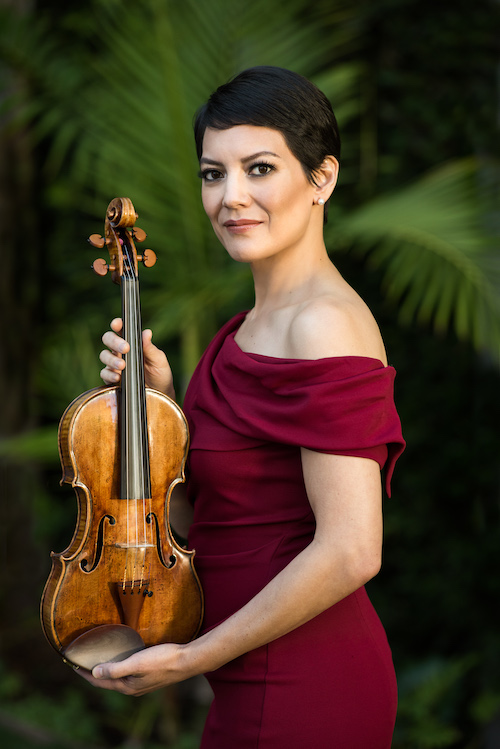Violinist Meyers shines in a night of shlock with L.A. Philharmonic

For one born and raised in California, it was hard not to be embarrassed by the schlock that the Los Angeles Philharmonic brought to Carnegie Hall Wednesday night.
It was one of those nights when one couldn’t quite tell whether it was the repertoire or the performance that was bad. But there seemed to be little of musical interest in the two New York premieres by Mexican composers, both written last year: Kauyumari by Gabriela Ortiz and Fandango for Violin and Orchestra by Arturo Márquez.
And conductor Gustavo Dudamel took Copland’s Third Symphony, a rhetorical, inflated piece to begin with, and blew it still more full of hot air.
The audience reaction? Rapturous applause, loud and long, on their feet.
So we’d better address what was good about the concert. If you enjoy being blown away by a large, well-coordinated symphony orchestra going full blast—and who doesn’t?—you came to the right place Wednesday night. Maestro Dudamel apparently never met a crescendo he didn’t like—or play just like the previous one. One wondered how many bass drums the orchestra has worn out on its current tour.
Also on the plus side was the soloist Anne Akiko Meyers, who is a wonderful violinist. Her full, rich tone projected easily throughout the hall, she dazzled with her fluent technique, and her phrasing was unfailingly musical even when there wasn’t much to work with.
The piece composer Márquez wrote for her was a standard three-movement concerto in all but name—and furthermore, an unabashedly Romantic one—as if Márquez aspired to be the Mexican Wieniawski. That’s okay, in our current anything-goes new-music scene. If it made the L.A. Philharmonic sound like the Hollywood Philharmonic, that’s okay too. Stylistic versatility counts.
The problem was finding the “there” there. The composer explained quite a bit about Mexican regional traditions and genres in a program note, but in the performance one was aware mostly of the soloist arching out a phrase or two, then launching into a flurry of Paganini-style pyrotechnics—racing scales, lightning string-crossing, dizzying leaps, familiar stuff but still amazing—while the orchestra plunked along as a kind of rhythm section, laying down various Latin beats. Though titled “Plegaria,” the middle movement didn’t seem “prayerful,” but just miscellaneous episodes in various tempos without any overall message.
The Ortiz piece that opened the program was similarly elusive, to put it kindly. It opened promisingly with distant thunder in the timpani, a drip of percussion rain, and a “sunrise” for brass and winds, then settled into a phrase repeated over and over with changing orchestration, in what might be called a bit of Meximalism.
The composer’s program note said the title referred to a “blue deer” that the Huichol people of Mexico revere as a spiritual guide. Meaning no disrespect to Native American religion, but this deer proved as hard to discern in Ortiz’s circling score as the “enigma” in Elgar’s variations.
On the other hand, what Copland was about in his Third Symphony was not obscure at all: to take the folk tropes and spacious intervals that had earned this formerly spiky modernist renown as America’s Composer, and massively orchestrate them to make the Great American Symphony.
It turned out to be an enterprise best left to symphonists by temperament such as Roy Harris, David Diamond and William Schuman. Hearing this music, one couldn’t help recalling the immortal words of Mayor LaGuardia: “When I make a mistake, it’s a beaut.”
Copland compounded his “beaut” by taking a piece that was perfect in itself, the Fanfare for the Common Man, and subjecting it to pointless symphonic complications in the overheated finale.
One still awaits a performance of this symphony that finds a reason for it all. Bernstein’s was at least contained, wiry, and moving forward. Dudamel’s on Wednesday—which often meandered in the “big sky” moments, and whose frequent fortissimos seemed to leave the players too exhausted to play well softly—was a lot of noise to little effect.
Carnegie Hall presents the Philadelphia Orchestra conducted by Yannick Nézet-Séguin, with pianist Beatrice Rana, in works by Ravel, Price, and Clara Schumann, 8 p.m. Friday. carnegiehall.org.
Posted Oct 27, 2022 at 6:23 pm by Jaime Herrera
Magnificent review. I knew someone would (sooner or later) call these works what they really are: “much ado about nothing.” And, you did it with admirable restraint, professional courtesy, and erudition. Bravo!!
Posted Oct 27, 2022 at 11:52 pm by Just saying
I get it, the reviewer is clearly biased against the LA Philharmonic, which seems to be our country’s hottest orchestra at the moment. But this review seems to be more a criticism about the repertoire than the playing itself.
Posted Oct 28, 2022 at 8:46 am by George
Enjoyed this review but was it really so bad? If the audience leaps to their feet cheering, the LA Phil has clearly done something right.
At a time when classical music struggles to bring back audiences, and the average concert hall is a sea of white hairs, I see nothing objectionable about music that speaks on a visceral level.
Posted Oct 28, 2022 at 12:14 pm by John F Kelly
To quote Erich Leinsdorf “not every concert has to be a spiritual experience.” This certainly wasn’t. But it was fun. And played with extraordinary virtuosity. Not a single fluff in the brasses in the Copland. Outstanding.